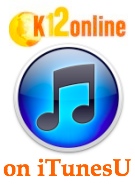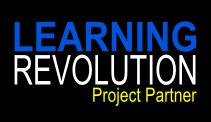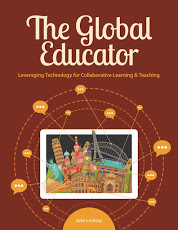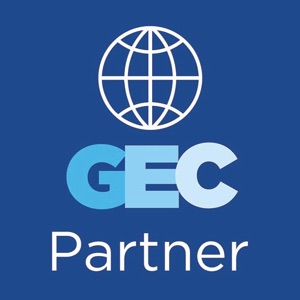Clarence Fisher Snow Lake, Manitoba, Canada
Blog: www.evenfromhere.org
Twitter: @glassbeed
Bio Clarence has been a classroom teacher for the past 13 years. He blogs professionally at remoteaccess.typepad.com, with his class at thinwalls.edublogs.org and has spoken at conferences across North America. Clarence has won several awards, including one of Canada’ highest teaching awards, the Prime Minister’s Award for Teaching for his integration of technology into daily classroom life. Clarence’s innovative classroom practices have been featured online, in books, magazines, and newspaper articles. He is an advocate of classroom 2.0, learning spaces that take complete advantage of the tools that are available to learners in their quest to learn rather than having school be something that is done to them.
Bio Page https://k12online07presenters.wikispaces.com/Clarence+Fisher
Presentation Title“Classroom 2.0 or You Live Where?”
Description Classroom 2.0 is a “slippery concept” that can look different in different communities and schools. But there are some basic concepts that bring value to these classrooms, a few basic ideas that need to be considered by teachers who are looking to make changes to their classrooms. These classrooms are not just about teachers allowing their students to have weblogs, but about what we consider to be basic goals for education, how learning happens in global networks and the possibilities for our students to be legitimate contributors in their own right. Where have we been so far on this journey of change? What are some of the big ideas that we need to consider and where do we need to go next?
iPod ready http://k12online.wm.edu/ipod_classroom2.0.m4v (19:02 Run Time; mpeg4; 108.1 MB)
Original http://k12online.wm.edu/Classroom2.0.mov (19:02 Run Time, mov, 88.5 MB)
Audio only http://k12online.wm.edu/Classroom2.0.mp3 (19:02 Run Time; mp3; 2.1 MB)
What is “Take My Hand”?“Take My Hand” Access Help Desk
[tags]k12online07cl01, k12online07[/tags]








Thanks Wes and K12Planners!! I just sent this to my teachers!
I’ll be showing some screen shots at tomorrow’s staff meeting to encourage the others to tune in and find out what the internet holds for their students. Thanks for taking us on a tour, love seeing into other spaces.
Thanks Clarence; you’ve set the tone for this week’s sessions and given me lots to think about in terms of relationships – with information, curriculum, pedagogies, and learners around the globe. It may not matter where you live, but your piece of the world sure looks gorgeous!
Clarence,
Thanks for framing the issues so well. Your presentation was beautifully filmed, invitational, and inspiring.
It’s provided a great entryway to the conference or for teachers pondering the real changes web 2.0 makes in their classrooms.
I kept stopping every other frame to take notes, because you said it all so well.
This will be a centerpiece of our campus workshops the next two weeks. Thank you!
Thanks, Clarence for addressing some philosophical issues regarding the changes in education. Even if we have all the great tools, our classes go nowhere if we continue the methods of the 1950s.
Thanks for this Clarence, I found it inspiring. I love the way your classroom is a haven within your school and community. 🙂
Wonderful presentation Clarence! Initial reaction, and one that I’ve been thinking about myself over the last couple of days…, it would seem that we need to teach our students to be the “teacher.” It would appear that many of our “issues” that we face in education today could be solved if we could turn the teaching over to the students. The tools are all there, easy to use, free, limitless library, and much better at telling a story than anything teachers have used in the past. What types of “issues” would this solve in education? What types of issues would this create? Would there be limits?
Never mind the teachers and administrators – I’m showing this to my high school Current Events class to see what they make of it! They will certainly identify with the small town setting. Let’s see if they can draw other parallels.
Clarence you are a great digital story teller. You wove the story around your classroom while reaching out to the world. Thanks for letting us be a part of your world.
Cheryl
I love the idea of checking out what blogs our students are reading, who is reading their blogs and getting to know those we are teaching. Thanks for a great start to the conference.
I’m just starting to watch this Clarence, and I’m loving the Rider cap! Thanks for bringing Rider Pride to the masses!
Wonderful presentation Clarence! Initial reaction, and one that I’ve been thinking about myself over the last couple of days…, it would seem that we need to teach our students to be “teachers.” It would appear that many of our “issues” that we face in education today could be solved if we could turn the teaching over to the students, literally. The tools are all there, easy to use, free, limitless resources, and perfect for telling stories beyond anything teachers have used in the past. What types of “issues” would this solve in education? What types of issues would this create? Would there be limits?
Thanks for a great podcast. Great ideas, fabulous scenery.
🙂 Enjoyed this presentation. Liked the way you let us be part of your world, as Cheryl commented earlier. Thanks.
Excellent presentation! Love to know there are more teachers out there thinking that way…. that I-m not the odd girl out. Thanks for sharing. I really enjoyed this presentatin… how do I know a presentation was good… when I finish watching with a smile on my face. Keep on shining!
A warm hug from Venezuela.
First of all, thank you for your kind thoughts and reactions. I found this keynote to b a challenge to produce simply because the field of classroom 2.0 has not yet been solidly defined and s such a new and emerging field. My idea behind this was to attempt to give some sort of shape and definition to this new idea. Before we can solidly begin moving our idea, we need to know where we are going. While I believe we have a long way to go before we can some to some sort of definition of what classroom 2.0 is and looks like; and while I presume this idea will continue to change under our feet, I am certainly glad that at least some people found this piece a helpful beginning.
This is my first time participating in this type of conferences-interaction and am really getting lots of input-
Clarence- I’ve been in EFL Teaching for almost 20 years – In 2000 I started my own “teaching place”- do you know what’s it called? English Studio. In 2000, when I opened it I wanted to offer potential students something different – after your presentation, which I really enjoyed watching yesterday I made a short videoclip set in “my” English Studio- And, incredibly though it may sound, YOU helped me know why English Studio is called like that.
I kindly invite you to visit the blog as well.
Now the link to the clip your presentation inspired:
http://english_studio.blogspot.com/2007/10/classrooms-as-studios.html
Thanks Clarence!
Two things resonate as I reflect on your presentation:
1. The need to establish a strong set of (global) enduring understandings/essential questions for my content (Biology) and the strategies (2.0 and others) to develop that understanding.
2. Local residency no longer means local employment.
This is fabulously done! I love the idea of thinking as classrooms becoming “studios.” Brilliant!
Clarence, I appreciate your final thoughts that technology is about making connections and not about specific skills that students can reproduce. Thanks for the presentation!
Wow! This keynote is outstanding! Thanks Clarence for giving us such a grand start! I blogged about it at:
http://anne.teachesme.com/2007/10/16/classroom-20-keynote-from-clarence-fisher/
Clarence, I really enjoyed seeing your home environment and hearing you speak with such conviction about the need for a change within ourselves if we are to make Classroom 2.0 a reality around the world.
The aim is to be fearless in the face of change and to embrace it as a friend. What struck me during your presentation was how you enjoyed the security of your own environment but worked hard at bringing the world in to be a part of your pedagogical approach, your curriculum and your every day professional relationships.
Thank you for your inspiration and affirmation.
Echoing what was said earlier, great video. I really like the way you describe a classroom as a studio. What more could we ask of classroom than to be a creative center of collaboration and growth?
I like your piece because it can be shown to people who have never heard these concepts before. It’s not overloaded with tool names, it just sets the stage for what you want to accomplish with your students. I’m sending a direct link to the teachers in my school. I’ve already suggested the conference – this is a good first piece for people to watch.
While you weren’t explicit about this , I sensed great pride with where you live and what you’re learning. That’s something everyone needs to consider. In some ways some might see your location as being an obstacle. If it is, you’ve certainly turned it into an opportunity.
Clarence,
Thanks for taking the time to share this inspirational video. I must say, I’m right there with you (well, at least my first foot is!), but the old world is dragging me back some.
My concerns/questions:
I use many of the tools you tossed out there – blogs, wikis, podcasts, videos to teach things, students teaching some things, studio-esce classroom atmosphere, etc., but (you had to know there was a BUT coming!), I am expected to give quizzes and exams and grades that fit on report cards.
How do you reconcile the realization WE have of how the classroom must change to serve our students’ needs, with the existing structure of our schools and the expectations of parents and administration?
I love the way you explained what I’ve been doing for the past few years – ‘changing my relationship with the curriculum’ – but, again while I’m changing, the school structure is not. I’m trying to effect that change and I feel like there is progress, but, in the mean time, how do you deal with the expected nature of school?
Thanks again for sharing your ideas. Keep leading us in the right direction!
I’ve been thinking for several days about your closing thoughts on the need for a new tool to measure the depth and direction of students’ learning. I think you called it “education informatics.” After watching several sessions in the Professional Learning Networks strand, I would add that education informatics also would be invaluable for measuring teacher professional development.
My district in East Tennessee (USA) recently reduced the number of systemwide PD days and tripled the number of hours (from 6 to 18) that teachers must document for unscheduled inservice learning. But I don’t know if too many administrators are equipped or even willing to acknowledge web-based pursuits via wikis, webcasts, chats, forum discussions, and so on. I think documentation and accountability would be huge issues to overcome. So, I would add that as teachers learn and become more adept at growing out their networks this process needs to become transparent too.
Well, Clarence, you’ve put a lump in my throat.
Because of the truth you speak so beautifully.
Because you hit every point squarely on the head.
Because you are a classroom teacher.
I will do everything I can to get others to watch this. Thank you so much – Mark
As I sit in my classroom setting up for the day, I am reminded of how important it is for me to build that “studio here”. It isn’t about filling up the day with busy work. It is about creating an environment that will foster creativity, collaboration, and learning. Easier said than done. 🙂 Thanks for the inspiration.
Thank you for the inspiration and excellent modeling of what a 21st century classroom should look like. The way you frame your points will ring true with even the most luddite among my colleagues.
Creating an environment that will foster creativity, collaboration and learning while using new tools in the classroom is a tough act. I can see why many teachers stay with the old ways of delivering the curriculum. I am surrounded by quite a few teachers in my school who does not believe their students can be creative, dynamic, critical thinkers or citizens. Its’ a shame. They are also closed to new tools students need in the future. Depressing as this may be, I am also around teachers who are very dedicated to their profession and who continually seek ways of improving their teaching. There are teachers at my school who stives to learn the new tools for themselves and their students. So, there is hope afterall.
I like the idea to create a studio in the classroom but for me this is still a challenge. When you teach high level of math classes to show the real life application is already a challenge. It seems that collaborating with other teachers in school is not enough. May be I need to expand my network!
There’s no question that the possibilities for learning through technology are vast. With networked computers, the classroom is no longer confined to its four walls, and school is no longer confined to its campus. I do think we must keep our enthusiasm in check a little, especially in classrooms where are students are not reading and writing at grade level. In our highly technological society, fewer students are reading for pleasure and many schools are floundering. You’d think there would be an opposite trend with all the resources as our disposal.
I like Clarence’s statement that learning is a collective process. How right he is!! It takes a whole “village” to teach a child. It is important to collaborate with all stakeholders involved in this process.
Hi Clerence,
I am in Dean Shareski’s class, and I just wanted to say that I like the way you related networks so much to daily life. For some people who may be reluctant to learn technology and change, this could very well be the key to them realizing the importance of online tools and how they connect you with the rest of the world. I think students should get the opportunity to be in classrooms like this all the time.
Clarence, Thank you for addressing such an important subject. I really enjoyed your presentation. It truly does open one’s eye’s about why classroom 2.0 is so important in today’s ever changing society. You have shown that students can actually be teach themselves and create their own work if given the access to the correct tools (which are free). You have addressed a very important need for educators to act as facilitators of knowledge. Collaboration and networking is they key to teaching in today’s world. I just wish more people in school administration felt the same. Thanks for all the great classroom ideas and tools, your tour was really great.
Clarence, I really enjoyed your presentation. I, like you, question the curriculum that we teach our children. Does the traditional liberal arts curriculum still fit our information-rich landscape? Do we continue to teach our students the same skills and concepts we learned as students? Are we truly preparing them for their future or our past? Thank you for sharing your part of the world with us.
Pingback: Final Reflections & Project for K12Online07 Conference | Learning, Teaching & Technology
Pingback: K-12 Online Conference Reflection on Clarence Fisher’s Classroom 2.0 Keynote | Learning, Teaching & Technology
Pingback: Education informatics and the teacher/learner « ThinkTime